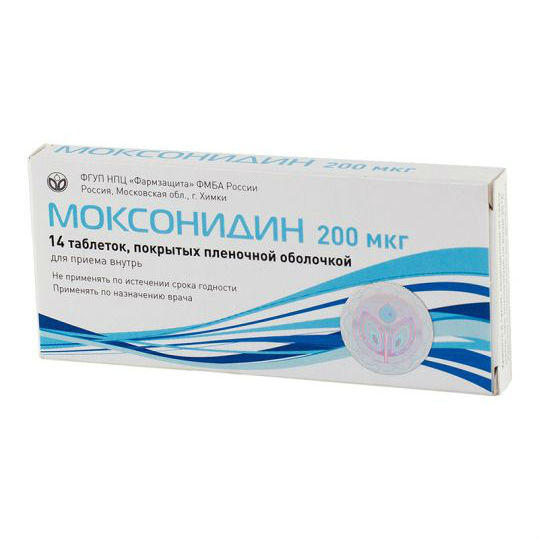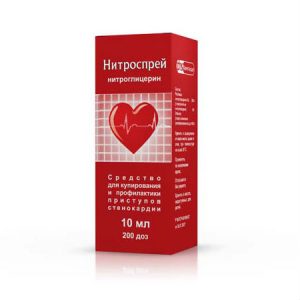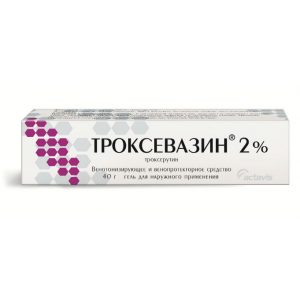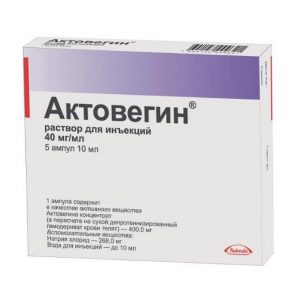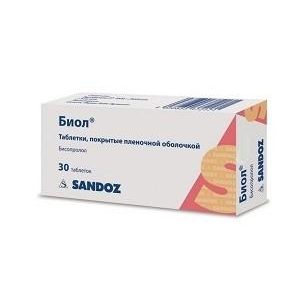Description
Release form
Tablets.
Packing
14 pcs.
Pharmacological action of
Pharmacodynamics of
Selective agonist of imidazoline receptors responsible for tonic and reflex control of the sympathetic nervous system (localized in the veno-lateral region of the medulla oblongata). Lowers blood pressure (BP). Slightly associated with central alpha2-adrenoresponsors, due to the interaction with which dry mouth and sedation are mediated.
Reduces tissue resistance to insulin.
Effect on hemodynamics: a decrease in systolic and diastolic blood pressure with a single and prolonged administration of moxonidia is associated with a decrease in the pressor effect of the sympathetic system on peripheral vessels, a decrease in peripheral vascular resistance, while cardiac output and heart rate (HR) are not significantly changed.
Pharmacokinetics
Absorption after oral administration – 90%. Eating does not affect the amount of absorption. Bioavailability is 88%. Communication with blood plasma proteins – 7%. Cmax in plasma is determined 30-180 minutes after oral administration and is 1-3 pg / ml. Distribution volume – 1,4-3 l / kg. Passes through the blood-brain barrier. It does not cumulate with prolonged use. The elimination half-life is 2-3 hours. The kidneys are excreted by 90% (70% – unchanged, 20% – in the form of metabolites). Significant differences in pharmacokinetics in young and elderly patients were not found.
Contraindications
Hypersensitivity to drug components, sinus node weakness syndrome, sinoatrial and atrioventricular block II and III degree, severe bradycardia (heart rate less than 50 beats / min.), chronic heart failure III and IV class (NYHA classification), history of angioedema, unstable angina, severe liver failure, chronic renal failure (creatinine clearance less than 30 ml / min., creatinine more than 160 mmol / l), age under 18 years (efficacy and safety have not been established), pregnancy and lactation, simultaneous administration with tricyclic antidepressants.
Precautions: Parkinson’s disease (severe), epilepsy, glaucoma, depression, intermittent claudication, Raynaud’s disease, grade I atrioventricular block, chronic renal failure (creatinine clearance greater than 30, but less than 60 ml / min.), cerebrovascular disease, after myocardial infarction, chronic heart failure I and II class, severe liver failure – due to a lack of experience with application, hemodialysis.
Use during pregnancy and lactation
There is no clinical evidence of a negative effect on pregnancy. However, care must be taken prescribing moxonidine to pregnant women. During treatment, it is recommended to stop breastfeeding (penetrates into breast milk).
Special instructions
If it is necessary to cancel the simultaneously taken beta-blockers and moxonidine, first beta-blockers and, only after a few days, moxonidine are canceled. It is not recommended to prescribe tricyclic antidepressants simultaneously with moxonidine. During treatment, the use of alcohol is excluded. During treatment, regular monitoring of blood pressure, heart rate and ECG is necessary.
Moxonidine may be prescribed with thiazide diuretics, ACE inhibitors, and slow calcium channel blockers.
Moxonidine should be discontinued gradually.
Ingredients
Active ingredient: midecamycin acetate 200 mg
Excipients: methyl parahydroxybenzoate propyl parahydroxybenzoate acid citric sodium hydrophosphate anhydrous flavor banana dye Sunflower sunset yellow FCF sodium sulfide nitrite 49 garnolpfinum nitrate sodium sulfide 29, silicone sulfate 49 2 mg
Excipients: microcrystalline cellulose, Aerosil A-380, polyvinylpyrrolidone, magnesium stearate, hydroxypropyl cellulose (clucel), castor oil, tween-80.
Dosage and administration
Inside, regardless of food intake, with plenty of fluids. In most cases, the initial dose of moxonidine is 0.2 mg per day, in one dose, preferably in the morning. If the therapeutic effect is insufficient, the dose can be increased after 3 weeks of therapy to 0.4 mg per day for 2 doses or once. The maximum daily dose, which should be divided into 2 doses (morning and evening), is 0.6 mg. The maximum single dose is 0.4 mg.
In elderly patients with normal renal function, the dosage recommendations are the same as for adult patients.
In patients with renal failure (clearance of cretinin 30-60 ml per minute) and patients those undergoing hemodialysis, a single dose should not exceed 0.2 mg, the maximum daily dose of 0.4 mg.
Side effects of
Especially at the beginning of therapy, the most common adverse reactions were: dry mouth, headache, dizziness, asthenia, peripheral edema, allergic reactions, nausea, constipation, drowsiness. The intensity of their manifestation and frequency decrease with repeated use. Reported cases of anorexia, pain in the parotid gland, urinary retention or incontinence, dry eyes, orthostatic hypotension, Raynaud’s syndrome, endocrine disorders, gallstone disease.
Drug Interactions
Moxonidine may be prescribed with thiazide diuretics and slow calcium channel blockers. With the combined use of moxonidine with these and other antihypertensive drugs, a mutual increase in the effect of moxonidine occurs.
When prescribing moxonidine with hydrochlorothiazide, glibenclamide (glyburide) or digoxin, there is no pharmacokinetic interaction.
Tricyclic antidepressants may decrease the effectiveness of centrally acting antihypertensive drugs.
Beta-blockers increase bradycardia, the severity of the negative foreign and dromotropic effects of moxonidine.
Moxinidine moderately enhances cognitive decline in patients taking lorazepam.
The administration of moxonidine together with benzodiazepines may be accompanied by an increase in the sedative effect of the latter.
When prescribing moxonidine together with moclobemide, there is no pharmacodynamic interaction.
Overdose
Symptoms: headache, sedation, drowsiness, excessive blood pressure decrease, dizziness, general weakness, bradycardia, dry mouth, vomiting, fatigue, stomach pain. Short-term increases in blood pressure, tachycardia, and hyperglycemia are also possible.
Treatment: symptomatic. Gastric lavage (immediately after administration), administration of activated charcoal and laxatives, symptomatic therapy. In the event of a decrease in blood pressure, it is recommended to restore the volume of circulating blood due to the introduction of fluid. Bradycardia can be stopped with atropine. Alpha-adrenoreceptor antagonists may reduce or eliminate transient arterial hypertension when overdosed with moxonidine. Idazoxan (an imidazolin antagonist) is administered as a specific antidote.
Storage Conditions
In a dry, dark place.
Shelf life
2 years.
Deystvuyushtee substance
Moxonidine
Terms and conditions
prescription
dosage form
tablets
Possible product names
MOXONIDINE 0.0002 N14 TABLE S / L
Moxonidine tablet s / n / o 0.2mg N14 pack contact ind pack
MOXONIDINE TAB. P.O. 0.2MG No. 14 (7X2)
MOXONIDINE TAB. P / O 200MKG No. 14
Moxonidine tablets 0.2 mg, 14 pcs.
Federal State Unitary Enterprise Pharmaceutical Protection Scientific and Technical Center, Russia
